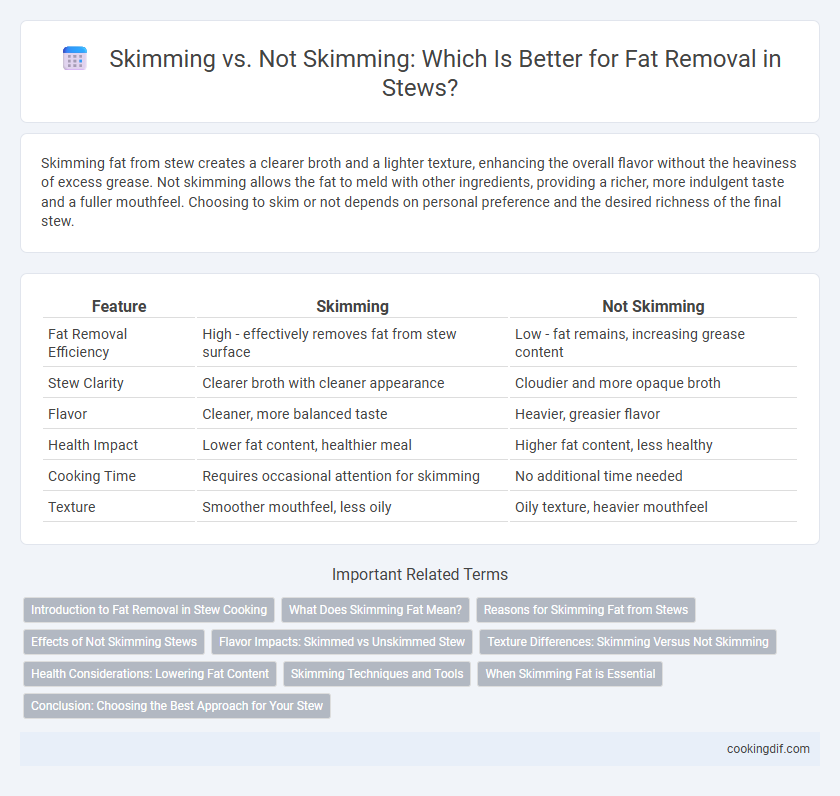Skimming fat from stew creates a clearer broth and a lighter texture, enhancing the overall flavor without the heaviness of excess grease. Not skimming allows the fat to meld with other ingredients, providing a richer, more indulgent taste and a fuller mouthfeel. Choosing to skim or not depends on personal preference and the desired richness of the final stew.
Table of Comparison
| Feature | Skimming | Not Skimming |
|---|---|---|
| Fat Removal Efficiency | High - effectively removes fat from stew surface | Low - fat remains, increasing grease content |
| Stew Clarity | Clearer broth with cleaner appearance | Cloudier and more opaque broth |
| Flavor | Cleaner, more balanced taste | Heavier, greasier flavor |
| Health Impact | Lower fat content, healthier meal | Higher fat content, less healthy |
| Cooking Time | Requires occasional attention for skimming | No additional time needed |
| Texture | Smoother mouthfeel, less oily | Oily texture, heavier mouthfeel |
Introduction to Fat Removal in Stew Cooking
Skimming fat during stew cooking effectively removes excess grease, resulting in a clearer broth and lighter texture. Not skimming allows fat to emulsify into the stew, enhancing richness and mouthfeel but increasing calorie content. Choosing whether to skim depends on desired flavor intensity and nutritional goals in your stew preparation.
What Does Skimming Fat Mean?
Skimming fat in stew involves removing the layer of fat that rises to the surface during cooking, resulting in a cleaner, less greasy texture and improved flavor clarity. This process helps reduce excess fat content, making the stew healthier and preventing an overly oily mouthfeel. Not skimming fat allows the richness of the fat to remain, which some prefer for enhanced taste but can lead to a heavier, fattier dish.
Reasons for Skimming Fat from Stews
Skimming fat from stews enhances the dish's clarity and reduces greasiness, improving both appearance and texture. Removing excess fat also helps create a lighter, healthier meal by lowering calorie and saturated fat content. This process prevents an oily mouthfeel, allowing the natural flavors of the ingredients to shine more distinctly.
Effects of Not Skimming Stews
Not skimming stews allows fat to remain on the surface, resulting in a richer flavor and deeper mouthfeel but can also cause a greasy texture and cloudy broth. Excess fat can hinder the absorption of seasonings and reduce the stew's overall clarity and visual appeal. Leaving fat unskimmed may negatively impact digestion for some individuals, making the stew heavier and less suitable for low-fat diets.
Flavor Impacts: Skimmed vs Unskimmed Stew
Skimming fat from stew removes excess grease, resulting in a lighter, cleaner flavor that highlights vegetables and lean meats. Leaving fat unskimmed enriches the stew with deeper, more robust taste profiles as the fat carries and intensifies the spices and aromatics. However, excessive fat may overwhelm subtler flavors, impacting balance and mouthfeel.
Texture Differences: Skimming Versus Not Skimming
Skimming fat from stew results in a lighter, clearer broth with a smoother texture, enhancing the perception of freshness and reducing greasiness. Not skimming retains fat, which adds richness and body, producing a thicker, more velvety mouthfeel but may create a heavier, oilier texture. The choice between skimming or not directly affects the stew's mouth-coating quality and overall taste experience.
Health Considerations: Lowering Fat Content
Skimming stew to remove fat significantly reduces saturated fat content, lowering calorie intake and promoting heart health. Leaving fat in stew increases fat-soluble vitamins absorption but may elevate cholesterol levels and inflammation risk. Choosing to skim supports weight management and cardiovascular benefits by decreasing overall fat consumption.
Skimming Techniques and Tools
Skimming techniques for fat removal in stew involve carefully removing the fat layer that rises to the surface using specialized tools like a fine mesh skimmer, ladle, or fat separator. Effective skimming enhances the stew's texture and flavor by reducing greasy residue and preventing excess oil from overpowering the dish. Employing a chilled spoon or a dedicated fat remover ensures precise fat extraction, maintaining the stew's rich, balanced taste.
When Skimming Fat is Essential
Skimming fat during stew preparation is essential for achieving a clear, flavorful broth and preventing greasy texture. Removing excess fat enhances the stew's overall mouthfeel and allows other ingredients' natural flavors to shine. Failure to skim fat can result in a heavy, oily stew that reduces palatability and visual appeal.
Conclusion: Choosing the Best Approach for Your Stew
Skimming fat from stew results in a lighter, healthier dish with clearer broth and enhanced flavor clarity, while not skimming preserves richness and mouthfeel, catering to those who prefer a heartier texture. The optimal approach depends on dietary preferences and desired stew consistency, balancing health considerations against flavor depth. For a balanced stew, partial skimming offers a middle ground by reducing excess fat without sacrificing all richness.
Skimming vs Not Skimming for fat removal Infographic

 cookingdif.com
cookingdif.com